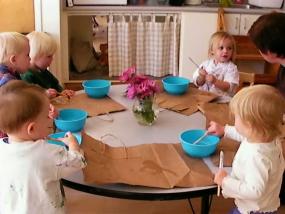Twos Paint with Water - Mark versus Media

Diane has placed bowls of water, segments of brown paper, and paintbrushes at a circular table for the five children above to use. She wants to know how the children will “read” this situation. She also wants to know if they will read her actions when she makes watermarks on her paper. When children see a set of objects, they immediately assimilate the objects to particular action schemes, sort of like scripts that have a sequence of actions. Dip brush in water, bring brush to paper, stroke brush over paper, look at mark. We could call this sequence the “marking” script. Ava and Kayle read the objects as part of the marking script. Other children assimilate these objects to another script; for example, Will, who puts two brushes in the water bowl, stirs the water, lifts the brushes, lower the brushes, and stirs some more. He seems to be more interested in the action of the brush on the water itself as opposed to the marks it might make on the paper. We could call this the “medium” script. He is exploring the action of the medium (the water) itself, not some trace of an action it records on the brown paper.
We might conclude that the mark script is more advanced than the medium script. It may well be, but on another day Will could be intent on making specific marks, and Ava could be lost in the joy of stirring the water in the bowl. We can evaluate the complexity of the action script without setting the developmental level of the child. Diane understands that marks require high-level thinking. The mark is more distal to the action that produced it and is an early kind of symbol, a symbol for the shape of the brush’s movement. Toward the beginning of the clip, she names the marks that Manny and Ava have made. She asks Will how he is making marks, but then notices that he is banging the water with his brushes. She affirms his strategy by saying, “Oh, you just like to work with the water? Okay. You work with the water.”
Later we will see how Diane experiments with her own paper, inviting the children to watch or not watch what she is doing. Using this indirect method of modeling without an explicit invitation or without framing this as: “I want you to do what I am doing,” she shows that she trusts the children to let her know naturally what they read and what they do not read when looking at her actions. They might read the energy of her mark making and apply that energy to rapid stirring of the water. They might read the growing wetness of Diane’s paper and attempt to cover their paper with water rather than make a defined line. They might read Diane’s distinct mark and take care to create a defined water line with a controlled stroke. Diane understands that what her actions cause a child to do can be treated as the child’s interpretation, a reading that tells her a great deal about how the children think and what aspects of the world are most salient at this time.
Run time: 8 minutes, 58 seconds. Note: The downloaded folder will contain a high resolution video file, suggestions for how to use this clip for instruction, and action transcripts fortwo of the five children from the beginning to the end of the 9 minute clip.
